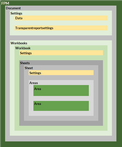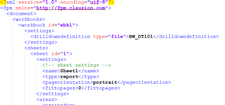The contents of the XML definitions file can be characterized like boxes within boxes. The outer box is defined first, and within it are smaller boxes, which in turn may contain smaller boxes of their own. In XML language these 'boxes' are called elements.
The following figure shows the XML file 'boxes' defining an area on a template.
Figure 17: XML file 'boxes' defining an area
•Area: the area is named, an id is given, and its type is specified. Area name must be the same as in the Excel workbook.
oSettings: definitions concerning the whole area are made
▪Basicareasettings: definitions mainly affecting the appearance of the area
▪Customareasettings: in custom templates only
▪Subtotals: may be used with row generation
oDefinitioncolumns: definitions of what data is shown on rows, for example accounts and/or units
▪Definitioncolumn: which attribute of the content is shown in this column, for example, account code, unit name
▪Generates: specifying how row content is created in row generating templates
oDatacolumns: columns where the facts data is shown, for example, euros, pieces or percentages
▪Generates: specifying how column content is created in column generating templates
▪Headers: defining data column headers
▪Settings: details about data retrieving in some special cases
▪Datacolumn: data content of one column
In Clausion FPM a portion of an XML definitions file defining an area may look, for example, like in the following figure.
Figure 18: Portion of XML defining an area
In addition to the definitions of areas and their sub-elements, there are definitions to be made for the sheet(s), workbook, and for the template in general.
The following figure shows the XML file 'boxes' surrounding the area box(es).
Figure 19: XML file 'boxes' surrounding the area box(es)
•FPM: standard content for the technical functionality of the template, content not shown in the XML editor
oDocument: standard content for the technical functionality of the template, content not shown in the XML editor
▪Settings: definitions in some special cases of templates
•Data: in custom templates only
•Transparentreportsettings: in TR templates only
▪Workbooks: standard content for the technical functionality of the template, content not shown in the XML editor
•Workbook: standard content
oSettings: specifications affecting the whole workbook (that is, all sheets and areas of the template)
oSheets: 'box' surrounding definitions of single sheets, in case of a multiple sheet template there may be some definitions here
▪Sheet: an id is given to the sheet
•Settings: the sheet is named, its type is specified, and settings mainly affecting the appearance of the sheet are made. Sheet name must be the same as in the Excel workbook.
•Areas: 'box' surrounding definitions of single areas, the order in which areas appear on the sheet is specified here
In the input and report templates task, a portion of an XML definitions file enclosing the area element(s) may look, for example, like in the following figure.
Figure 20: Excerpt from Simple Report that does not contain all possible 'boxes'
When opened in an editor outside Clausion FPM, a portion of the XML definitions file would look, for example, like in the following figure.
Figure 21: Portion of the XML definitions file in an external XML editor




